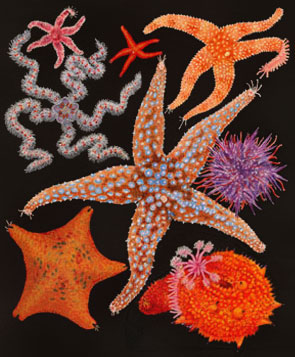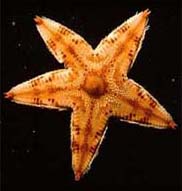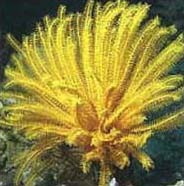Echinoderms
What are echinoderms?

Echinoderms are radially symmetrical animals. This means that the creatures have appendages (or a body construction) which point outward from the centre of the body like the spokes on a bicycle wheel. These appendages usually occur in multiples of five, although there are a few exceptions. Most can regenerate lost limbs.
They are only found in the sea (there are none on land or in fresh water). It contains about 6000 species, and gets its name from the Greek, meaning "spiny skin." Many echinoderms actually have "spiny" skin, but others do not.
They have bony ossicles in their body. They have a water-vascular system which pumps water through the madroporite. They also have small jaws that are supported by the water-vascular system. And they have tube feet which they use to attach to objects, for protection, as well as to obtain food. They are broken down into 5 different classes, which is looked at in more detail below.
Class 1: Asteroidea

A true starfish is classified in the Asteroidea, a group of echinoderms. They have no front or back: they can move in any direction without turning. Rather than using muscles to move their hundreds of tiny legs, starfish use a complex hydraulic system to move around or cling to rocks.
Most starfish are predators, feeding on sessile or slow-moving prey such as mollusks and barnacles. The aptly named crown-of-thorns starfish, Acanthaster, specializes on corals, and can do considerable damage to coral reefs. Many, but not all, starfish are able to turn a portion of their stomachs out through the mouth, and thus digest food outside of the body.
Class 2: Ophiuroidea

Ophiuroidea also known as 'brittle stars' or 'serpent stars'; have narrow, highly-flexible arms which are used in fairly rapid movement; most use arms in suspension feeding. The group includes about 2000 species, varying in color.
Ophiuroids can be found under rocks in most parts of the world, from the Arctic and Antarctic to the tropics. They eat decaying matter and microscopic organisms that are found on soft muddy bottoms. Almost all of the species are marine, although a few can live in brackish water.
Class 3: Echinoidea

The echinoids comprised of the sea urchins and sand dollars, differ from the other groups of echinoderms previously mentioned, in that they are globular, oval or sometimes disc-shaped. They also lack arms, but have five rows of tube feet that protrude through the hard outer body and allow the sea urchin to move by using a pulling motion. The most characteristic feature of the group is the presence of spines all over the body surface; the name Echinoidea means 'like a hedgehog'.
Sea urchins are herbivores, feeding primarily on algae. There are approximately 1,000 species of sea urchins and sand dollars making up class Echinoidea.
Class 4: Crinoidea

The crinoids which include sea lilies and feather stars are the most ancient and primitive, of all echinoderms. It contains about 600 living species and more than 2,000 fossil forms; the extinct crinoids are commonly called stone lilies.
Crinoids are suspension feeders. For example an Antedon uses the tube feet to trap particles of food. The mucus secreted by the tube feet is passed to a ciliated groove lying along the axis of the pinnule, by the constant bending and flicking of the tube feet. Particles of food are trapped in the mucus and are passed down the pinnules and the arms to the mouth.
Class 5: Holothuroidea

Holothurians are generally long and wormlike; they don't look much like starfish or sea lilies. Most holothurians are sluggish animals and use muscular contraction or the tube feet, in those species which possess them, to propel themselves slowly across the rock layer.
Holothurians retain pentameral (five-rayed) symmetry, with five rows of tube feet running from the mouth along the body. One way to think of a holothurian is as a sea urchin that is lying on its side, stretched out, and missing much of its skeleton.
Holothurians are common in the oceans of today. In certain parts of the deep sea, the ocean floor swarms with vast herds of holothurians. They are also common in shallow-water habitats such as tidepools.